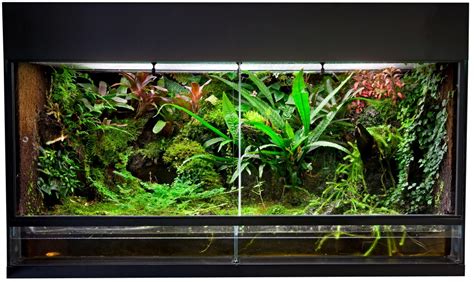Introduction
Maintaining the optimal temperature range is crucial for the health and well-being of tropical reptiles and amphibians housed in bioactive terrariums. Understanding the specific thermal requirements of different species and how to accurately measure and regulate temperatures is essential to ensure their comfort and avoid health issues.

Temperature Zones
Bioactive terrariums typically incorporate two primary temperature zones: a warm side and a cool side. Creating a temperature gradient allows reptiles and amphibians to thermoregulate by moving between different areas of the enclosure.
Warm Side:
- Ideal temperature: 85-95°F (29-35°C)
- Minimum temperature: 80°F (27°C)
- Maximum temperature: 100°F (38°C)
Cool Side:
- Ideal temperature: 75-80°F (24-27°C)
- Minimum temperature: 70°F (21°C)
- Maximum temperature: 85°F (29°C)
Temperature Measurement and Regulation
Accurately measuring and regulating temperatures is essential for maintaining optimal conditions.
Thermometers:
- Digital thermometers provide precise readings and are less prone to errors than analog thermometers.
- Place a thermometer on both the warm and cool sides of the terrarium to monitor temperatures.
Heating Devices:
- Heat lamps are a common way to provide heat in bioactive terrariums.
- Ceramic heat emitters (CHEs) produce infrared heat that penetrates deep into the enclosure, providing a natural source of warmth.
- Heat mats are placed underneath the terrarium to provide a gentle, ambient heat source.
Thermostats:
- Thermostats control the temperature by automatically turning heating devices on and off.
- Programmable thermostats allow for setting specific day and night temperatures.
- Dimmer thermostats provide precise control over heat output.
Factors Influencing Temperature
Several factors can affect the temperature within a bioactive terrarium:
- Enclosure Size: Larger enclosures tend to retain heat better than smaller ones.
- Substrate: Certain substrates, such as cypress mulch or coconut coir, have better insulating properties than others.
- Ventilation: Adequate ventilation is needed to prevent overheating, but excessive ventilation can cool the enclosure too much.
- Plants: Live plants can help regulate humidity and temperature by absorbing and releasing moisture.
- Hiding Places: Reptiles and amphibians need hiding places to retreat to in both warm and cool areas.
Special Considerations for Different Species
The optimal temperature range for tropical reptiles and amphibians varies depending on the species. For example:
- Green Iguanas: Warm side: 90-95°F (32-35°C), Cool side: 75-80°F (24-27°C)
- Leopard Geckos: Warm side: 90-95°F (32-35°C), Cool side: 75-80°F (24-27°C)
- Ball Pythons: Warm side: 90-95°F (32-35°C), Cool side: 80-85°F (27-29°C)
Conclusion
Maintaining the correct bioactive terrarium temperature for tropical reptiles and amphibians is essential for their health and well-being. By understanding the specific thermal requirements of different species and using accurate temperature measurement and regulation techniques, you can create a comfortable and healthy environment for your exotic pets.





















